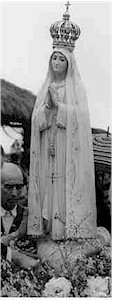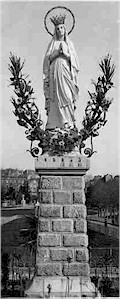Mary, the Air We Breathe
Mary, the Air We Breathe
A Long Tradition
– Theodore A. Koehler, S.M.
Through two millennia of existence, the Church formed and was formed by a very rich tradition. The mystery of Mary is part of that Christian tradition. Now, some people see it more as traditions, in plural, that are proper to the Marian doctrine and devotion. In reality, Mary is theologically part of the divine revelation, a part well integrated in our fundamental tradition. We may verify it in its various themes, for example in the poetic comparison of Mary to the air we breathe, so well expressed by the Jesuit Gerard Manly Hopkins (1844-1889).
The comparison of Mary to the Air goes back to the Middle Ages. A seventeenth-century Marian writer, Hippolytus Marracci, quotes in his Marian compilation (Polyanthea Mariana) four texts mentioning the theme "Mary and the Air" during the medieval period between 1200 and 1600.
When we compare medieval texts with modern ones, we touch the development of the Marian tradition. There are interesting differences that show how civilizations adapt to a unique fundamental tradition.

Our Lady of Fatima
THE MEDIEVAL TRADITION
God and His Creation
The Medieval mentality appears well in chapter XIX of a treatise devoted to Our Lady by the Franciscan Servasanctus who died in Florence (Italy) around 1300: it is a special chapter entitled "Mary is Called Air."
Servasanctus wanted to honor Mary with a kind of "psalter," similar to the 150 biblical psalms used in the Divine Office. Therefore, he wrote 150 chapters, 150 praises of Mary, comparing her with six kinds of symbols mentioned in the Bible: 1) heavenly symbols, Mary being called "light, sun, moon, cloud," and so forth; 2) earthly elements, like "air, sea, river, earth, garden"; 3)biblical plants and trees; 4) the world of life, Mary being called "bee, dove, sheep, heart," etc.; 5) products of arts and trades, like "book, mirror, vase, column"; 6) moral and spiritual symbols, like "mother, queen, daughter, sister."
In that vast context, chapter XIX praises Mary, calling her "air," since "she is the most blessed soul, happy conscience, celestial country, secure place, where we find nothing seducing, no aggressive enemy, no cloudiness, no darkness, no whirlwind, no trouble, no hailstorm, no tempest, but supreme and secure serenity, serene sincerity, sincere delightfulness, delightful tranquility, tranquil luminosity, luminous pleasantness, pleasant fertility, most fertile beatitude: all that meaning the perfect place gathering all goods. 'Lord, blessed the one who receives your help, who put in his heart the ascent [to the new Jerusalem],' (Ps. 83:6) visiting, for such a pilgrimage, that place constantly visited by the Lord God...."
Servasanctus describes Mary as the most perfect air, as the place that we have to choose for our pilgrimage to the heavenly Jerusalem, our eternal destiny. We must visit that air, since God is there in constant visit. The comparison of Mary with the air in which we live, is of cosmic order, fitting into the other comparisons with cosmic elements. We are in a medieval, monatic, symbolic mentality. The monks admired, praised the glory of God in their invisible union with the Divine Persons, and also in the visible creation: the universe that they knew with their limited sciences was the mirror that symbolized God and the invisible work of his divine grace in us. Servasanctus explains in his Exordium that God united in Mary all the masterpieces of his creation and of his order of grace. It is why, for example, we praise Mary as the perfect air, as the perfect place of our life.
OUR MODERN TIMES
The Insistence on our Personhood
Passing to the end of the seventeenth, and the beginning of the eighteenth centuries, we find the beautiful text of Saint Louis-Marie Grignion de Montfort (+1716): "When will souls breathe Mary, as much as bodies breathe air?" (Treatise of the True Devotion, n. 217) It is written in another mentality. Saint Louis-Marie de Monfort explains the role of Mary in our sanctification. He is not interested in some cosmic praise, but in our intimate union with Mary, as our best way of union with the Lord. We have to note that his treatise was discovered only in 1842 and published in 1843. The first English translation, made by F.W. Faber, was published by Burns and Lambert, in 1862. There were various other editions.
With Hopkins, we have to study a very personal development of the comparison. Is it completely original, or did Hopkins receive his inspiration from other writers?
Studies show that his poem reveals influences. Judith H. Fox, in her article on "The Queen of the Air: Transformation of Myth in Ruskin and Hopkins," notes the great debt of Hopkins to John Ruskins's comparison of Athene (the Greek Deity of Wisdom), to the air, made in "The Queen of the Air: Being a Study of the Greek Myths of Cloud and Storm."
Hopkins could have known the Montfortian text. His poem is dated May 1883. In that case, Saint Louis-Marie helped him to discover the Marian comparison. According to the documents about his life, he did not know the treatise of Servasanctus, that, at his time, was attributed to the famous archbishop Ernest of Prague.
TWO MENTALITIES
The poem of Hopkins has a cosmic touch. And there we see the modern differences with the medieval mentality of a Servasanctus, and also the originality of Hopkins.
For both writers, the comparison meant localization. For Hoskins, we live--spiritually--in the divine mercy, and also in Mary, as we live--physically--enveloped by the air. The poet celebrates first of all God. We breathe in the mercy of God. Now God gives us in Mary a special manifestation of his mercy.
"I say that we are wound
With mercy round and round
As if with air: the same
Is Mary, more by name."
We also breathe Christ:
"Bethlehem or Nazareth,
Men here may draw like breathe
More Christ and baffle death."
(vv. 65/67)
Both writers use a cosmic theme: the biblical, poetic use of the sapphire. Hopkins, according to commentators, probably knew the theme through Dante (Paradise Lost, XXIII, 100-102). He describes air:
"Again, look overhead
How air is azured;
O how!....(vv.73/750)
Yet such a sapphire-shot,
Charged, steeped sky will not
Stain light. Yea, mark you this:
It does no prejudice."(vv.79/82)
As pointed out before, the comparison of the sky with a sapphire is a medieval cosmic theme. It was inspired by the Bible, as Servasanctus explains with abundant quotations: for example, Ex 24:10: "Under the feet of God, Israel saw a sort of structure of sapphire, like the sky when it is serene." The blue gem, according to medieval goldsmiths, had remarkable properties, making it the most beloved stone. It was a cure of all kind of ailments: fever, eyes and front pains, ulcers of the tongue, plague. Servasanctus is not sure that all that is true for the sapphire, but he has no doubt that, in a spiritual meaning, all is true for Mary.
Hopkins ignores the medieval admiration for the sapphire. He notes only that the sapphire-blue skies do no prejudice to light. They do not stain it. His interest is not in the image, but in Mary. It is Mary who does no prejudice to our spiritual light, Christ. The sapphire-blue skies transmit the sunbeams, tempering, softening an ardor that would smite and burn us:
"Blue be it: this blue heaven
The seven or seven times seven
Hued sunbeam will transmit,
Perfect, not alter. (vv. 86/89)
...
Whereas did air not make
This bath of blue and slake
His fire, the sun would shake,
A bleak and blinding ball" (vv. 94/97)
...
In the same way, through Mary God became man, accessible, meek and humble. The Old Testament inspired awe before a redoubtable God. But with the mother of God, all changed:
"So God was God of old:
A mother came to mould
Those limbs like ours which are
What must make our daystar
Much dearer to mankind;
Whose glory bare would blind
Or less would win man's mind.
Through her we may see him
Made sweeter, not made dim,
And her hand leaves his light
Sifted to suit our sight." (vv.103/113)
Commentators (see N.H. Mackenzie, The Poetical Works of Gerard Manley Hopkins, 436-438) explain how Hopkins presents poetically the doctrine of Saint Bernard. For this influential doctor of the Church, God alone is source of grace, yet He has chosen Mary to give us Jesus, our life, and there fore we receive all graces through the hands of Mary. She is God's aqueduct. For Hopkins,
"(Mary) mothers each new grace
That does now reach our race."
(vv. 22,23)
He alludes to the glass-windows of the cathedrals, illuminated by the rays of the sun passing through them:
"Let all God's glory through.,
God's glory which would go
Through her and from her flow
Off, and no way but so." (vv.30,33)

Our Lady of Lourdes
THE HUMAN PERSON. THE PERSONAL TOUCH OF HOPKINS
The poet transforms the comparison of Mary with the air into his own personal discovery. The image becomes the prayer of a person, a personal union with Mary, and it is offered to the reader for his personal devotion.
"Be thou then, O thou dear
Mother, my atmosphere;
My happier world, wherein
To wend and meet no sin;
Above me, round me lie
Fronting my froward eye
With and scarless sky;"
(vv. 114/120)
Saint Bernard did not pray to Mary as his mother. Saint Louis-Marie de Monfort did. Hopkins is the human person who confides in Mary as her child. He loves God in her "mothering" air:
"Stir in my ears, speak there
Of God's love, O live air
...
World-mothering air, air wild,
...
Fold home, fast fold thy child."
(vv. 121, 122, 124, 126)
The Medieval monk calls Mary "air," in his praise of God and Mary, and he uses in the Bible all the symbols offered by the creation. Hopkins deepens our modern, subjective, personal approach. In his original, praying address, we find an invitation to breathe Mary, in order to breathe more Christ, the mercy of God. Thus, we are constantly "new Bethlehems," "new Nazareths."
These differences, in reality, express a fundamental tradition. We find in the poem of Hopkins the important theme of Servasanctus: Mary is our "happier world." Both writers are inspired by the same great tradition, well formulated by Saint Ambrose: "But blessed all of you who heard and believed. For any soul who believes, conceives and brings forth the Word of God...May the soul of Mary be in each of us to magnify the Lord." (Lk. 2, 26)
All About Mary includes a variety of content, much of which reflects the expertise, interpretations and opinions of the individual authors and not necessarily of the Marian Library or the University of Dayton. Please share feedback or suggestions with marianlibrary@udayton.edu.
